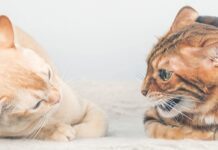Dear Elizabeth: I have four cats in my household and one of them, Tabitha, has a tendency to chew and eat plastic. Ive caught her chewing on plastic bags that Ive carried in from the store, as well as items in the basement that are wrapped in plastic. I worry that she could choke to death or hurt herself somehow. Why does she do this? One of my other cats is aggressive and chases her. Tabitha is afraid and will not fight back; could her plastic obsession be stress-related? Any ideas of what I can do? What a coincidence – one of our Feline Health Center veterinary consultants also has a cat, Maggie, who craves plastic. Maggie is a rather anxious cat, and nervous or stressed cats, like your Tabitha, are more prone to pica (eating nonfood materials). The most common targets for cats are wool, string and fabric, but any object can be targeted. We are hearing a lot lately about cats that are intent on chewing or eating plastic bags, plants or toys. Why is Tabitha attracted to plastic? To be honest, I cannot imagine why any cat in his or her right mind would want to eat anything other than food! Veterinarians and animal behavior experts have many opinions, but the truth is that no one really knows what causes pica in the vast majority of cats. Some have guessed that plastics may be made from animal products such as fats or fish oils, providing an irresistible temptation to cats, but this is not the case. Most likely, a variety of factors may be involved in pica. One thing is clear: Pica can lead to dangerous and even deadly consequences. While choking is rare in cats, ingesting fabric, string or plastic commonly leads to obstructions in the gastrointestinal tract, requiring emergency life-saving surgery. So where does that leave you and Tabitha? Clearly, you need to do everything you can to prevent Tabithas access to plastic. Dont use plastic bags to line your trash containers, at least not in rooms that Tabitha frequents. Store plastic bags in closets or cabinets, using childproof locks if Tabitha is clever enough (like me) to pry open doors. Pay particular attention when bringing home groceries in plastic bags until they can be safely stored away, and consider switching to paper bags or the more eco-friendly cloth bags that are so popular these days. Remove plastic plants or spray them with aversive substances like Bitter Apple. Watch for signs of a possible obstruction (vomiting, lethargy, anorexia) and contact your veterinarian immediately if you see any of these signs. Finally, go through the following list of possible causes and address any predisposing factors. Possible causes of pica include: Gastrointestinal disorders
Nutritional deficiencies
in cats that are not fed complete and balanced diets may result in pica. Even cats on a good commercial diet may benefit from increased levels of fiber in their diet. Some cats do better having some high fiber kibble available to snack on: Fiber will cause a feeling of fullness and may satisfy Tabithas need to eat excessively or chew. She may also appreciate potted cat grass or catnip to nibble on.Genetic causes
for a predisposition to wool-sucking and -chewing behaviors has been suggested in the Siamese and other Oriental breeds. Breeder management practices, such as early weaning of kittens, may also contribute to these behaviors and can be difficult to differentiate from genetic causes.Behavioral reasons
include boredom, stress and anxiety may be the most important contributors to pica. Chewing or sucking on objects may release endorphins, pain-relieving chemicals that also lead to warm feelings of well-being and comfort. In some anxious cats, chewing behaviors may serve as coping mechanisms, with the resulting endorphin rush becoming somewhat addictive and leading to the development of an obsessive-compulsive disorder. Feliway, a calming, pheromone-like substance reduces anxiety levels in some cats and has the added bonus, as for your household, of reducing aggression in some cases. Love, Elizabeth


